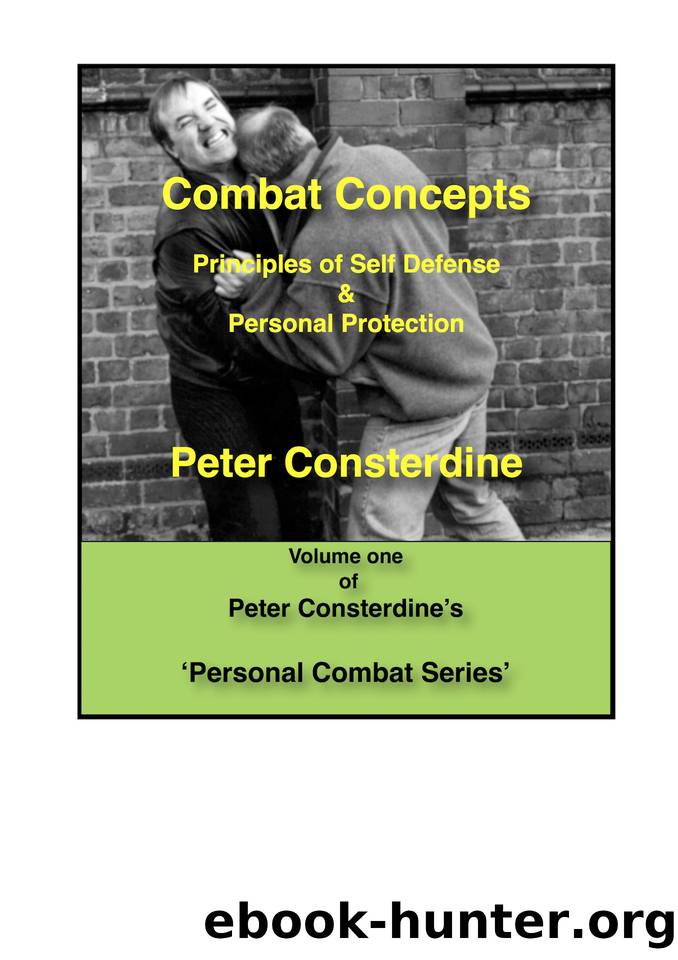Combat Concepts: Myths and Reality of Martial Arts for Self Defence (Peter Consterdine) by Consterdine Peter & Consterdine Peter

Author:Consterdine, Peter & Consterdine, Peter [Consterdine, Peter]
Language: eng
Format: epub, azw3
Publisher: Protection Publications
Published: 2020-10-07T16:00:00+00:00
Nothing harder than âhill carries.â Finishing is about mental resolve as much as physical
The chemical cocktail released is a mixture of Adrenalin, Cortisol, Dopamine and Endorphins and all designed to produce a specific effect. So my training changed and has been the same ever since. I train so as to increase the point at which I go âanaerobicâ and I train in the anaerobic zone. By doing this I achieve, broadly, two things. First I become very familiar with the feelings of distress associated with being anaerobic and second to get through the exercise drill this is only possible by the exercise of two things aggression and willpower. Even when you feel you have to stop during a hard drill â donât - but the caveat on that is that you have set a âtargetâ, either in time or distance, or repetitions, which you must complete. This may be 12 âwind sprintsâ across the gym, or 30 seconds wind sprints across the gym, or it may be you have to reach the top of a hill in a sprint. Anaerobic training is âgoal orientedâ, and whilst the goal must be achievable, it must only be achievable through very exceptional effort.
If, though, youâre new to anaerobic drills then set realistic goals to start with. Donât make them so hard that they will simply be unachievable, but as you get more used to the intensity of this type of training then make sure that each drill challenges your mental resolve to get to the end.
Before we go any further we need to look at fitness and what we mean by the word. We also need to explain some technical terms that weâve started to use. I firmly believe that we should never be allowed to use the word âfitnessâ on itâs own. Iâve had people who have told me they were fit who within the first 5 minutes of some anaerobic drills have gone off to be sick. They were fit, but only fit for what they were specifically good at. The word fitness should only ever used in conjunction with what we are fit for!
Fit to climb
Fit to swim
Fit to Run (marathons)
Fit to⦠(etc etc etc)
What I am concerned with primarily is being Fit To Fight (see my eBook with the same title on Amazon) . Many people who train often end up doing it without a purpose and without the knowledge about the effects our training has on us. Training for a marathon on flat roads will not enable you to pass a special forces selection course, when you are carrying over 50 lbs and trudging over uneven ground and with severe incline for 24 hours. Elements of marathon training will be relevant, but there will be a lack of muscular strength and muscular endurance to climb carrying weight.
So what are the elements of what we call fitness. They may be called different things when it gets technical, but we can refer to them as:-
Cardiovascular (CV) or respiratory capacity (heart
Download
Combat Concepts: Myths and Reality of Martial Arts for Self Defence (Peter Consterdine) by Consterdine Peter & Consterdine Peter.azw3
This site does not store any files on its server. We only index and link to content provided by other sites. Please contact the content providers to delete copyright contents if any and email us, we'll remove relevant links or contents immediately.
Shoe Dog by Phil Knight(4899)
The Rules Do Not Apply by Ariel Levy(4529)
Walking by Henry David Thoreau(3685)
Running Barefoot by Amy Harmon(3338)
I'll Give You the Sun by Jandy Nelson(3274)
How to Read Water: Clues and Patterns from Puddles to the Sea (Natural Navigation) by Tristan Gooley(3242)
Crazy Is My Superpower by A.J. Mendez Brooks(3208)
How to Read Nature by Tristan Gooley(3083)
How Music Works by David Byrne(2968)
The Boy, the Mole, the Fox and the Horse by Charlie Mackesy(2832)
The Fight by Norman Mailer(2709)
Seducing Cinderella by Gina L. Maxwell(2546)
Cuba by Lonely Planet(2490)
Accepted by Pat Patterson(2219)
Going Long by Editors of Runner's World(2215)
The Unfettered Mind: Writings from a Zen Master to a Master Swordsman by Takuan Soho(2160)
The Happy Runner by David Roche(2125)
Backpacker the Complete Guide to Backpacking by Backpacker Magazine(2111)
Trail Magic by Trevelyan Quest Edwards & Hazel Edwards(2063)
